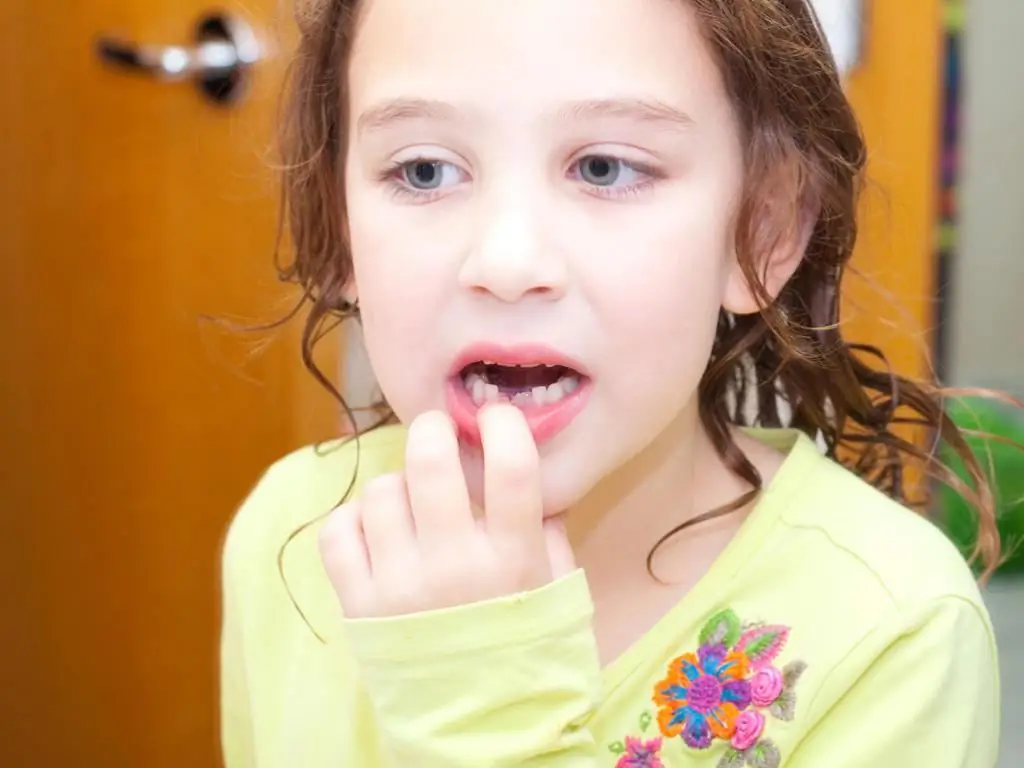2026 Author: Priscilla Miln | [email protected]. Last modified: 2025-01-22 17:55:13
Many people buying an adorable little puppy don't know if dogs have baby teeth and are unprepared for the challenges of changing teeth, which usually occurs within the first four to six months of life. Like small children, puppies experience discomfort, itching, and sometimes pain in their gums. During this period, they gnaw on everything that is not lying well, and can cause a lot of harm to furniture legs and other things.
What should an owner know?
The care of the owner during this period should not be limited only to feeding, raising and caring for the safety of his property.

Small and sharp puppy teeth also require constant attention of the owner. Especially if the pet's exhibition career is planned. The breed standards of canine organizations are very demanding on the presence of a full set of teeth and bites of a dog.
To make the change of teeth as painless as possible, the pet must have several goodsafe toys. Soft, flexible, easy-to-bend toys appropriate for the baby's size and special chew treats are preferred. Tendon bones and treats made from rawhide and jerky are great.
You cannot vaccinate a puppy during the teething period.
Puppy milk teeth
All dogs are born toothless, with bare gums. Starting at about two weeks of age, their first teeth erupt. By eight to ten weeks of age, most puppies are complete and have twenty-eight teeth. This is a complete set of milk teeth in dogs. Are there any exceptions? Everything happens in life, including dogs with fewer teeth, but a he althy dairy puppy should have twenty-eight. There is a general pattern: the larger the dog, the faster her teeth erupt.
Usually the fangs appear first - long sharp teeth. This happens in the third week of a baby's life. Next, the incisors begin to appear, six in each jaw. This usually happens in the fourth week. Premolars, or false-rooted teeth, will erupt last, they begin to grow at the age of three to six weeks, six on each side of the jaw, on the upper and lower. Puppies don't have molars.

There are some non-critical deviations from this sequence, when the fangs erupt almost simultaneously with the incisors, etc.
Tooth growth is delayed in miniature breed dogs, usually their first teeth appear at the sixth week of life.
AfterWhen all of your puppy's milk teeth erupt, it is recommended that you get checked out by a veterinarian. An experienced veterinarian can notice deviations in the formation of bite, and give recommendations for its correction, if possible.
Do dogs lose baby teeth?
Usually the first milk teeth fall out at the age of about four months. In a normally developed puppy, the change of teeth lasts approximately 60 days, and by six months the milk teeth are gone. As a rule, the fangs fall out last, and the end of the loss of milk teeth is not difficult to track.
Most of the time, puppies swallow their missing teeth in their food. Sometimes a tooth falls out when a puppy chews on something inedible. People who don't know if dogs have baby teeth are sometimes frightened by finding a missing tooth on the floor or a spot of blood on a soft toy.
Change teeth
Permanent teeth begin to erupt simultaneously with the loss of milk teeth. Each drop is replaced by a permanent one. But the sequence of loss of milk and growth of constants differs from the order of formation of the primary bite.

The hooks change first, then the middle and edges. Following them, the first molars, located immediately behind the premolars, grow. These teeth have no predecessors. Next, false-rooted premolars change. The last, as mentioned above, will grow permanent fangs. By eight to ten months, the pet should have a complete set of permanent teeth: twenty on the upper and twenty-two on the lower jaw.
In miniature breeds and brachycephalic dogsdue to the structural features of the muzzle 40 permanent teeth.
The complete change of teeth in puppies of large breeds, with normal development, ends at eight to nine months, in small breeds it should be completed by the year.
Puppy behavior during teething
Teething discomfort in puppies is often unnecessarily frightening for the owner. If the puppy is active, drinks, is interested in toys and willingly goes to communicate with the owner, but eats less and not so willingly, there is no problem. Sometimes there is a slight increase in temperature and diarrhea. If the puppy refuses food or communication, this is already a reason to take him to the veterinarian.
There is pain when changing milk teeth in dogs. Is it possible to help the pet in this case?

Pain and discomfort in the gums can soothe the cold. The most harmless and effective way is a frozen cube of homemade broth without spices. Another good and proven way to soothe the pain that dogs have during this period is to give a frozen carrot or apple to chew on, depending on what the pet likes.
When help is needed?
Do dogs have milk teeth, found out. And what to do with them?
If the puppy does not show signs of severe anxiety, it is best to let the baby teeth fall out on their own. But with signs of severe discomfort and soreness, inflammation of the gums, the help of a veterinarian is required. The answer to the question of whether a dog's milk teeth should be pulled out is ambiguous. Do not try to extract the tooth yourself. Even milk teethdogs have very long roots. Unqualified owner assistance can be harmful if a broken root remains in the gum and infection begins.

The exception is the case when the milk tooth does not stagger, but the permanent one already appears next to it. In this situation, the only correct answer to the question of whether it is necessary to pull out milk teeth in dogs is peremptory: "Definitely." If a milk tooth is left in place, this further leads to periodontal tissue diseases, which occur very quickly with constant gum injury by an incorrectly located tooth. If the grown tooth is strongly deviated to the side, injuries to the cheeks or tongue are possible.
Recommended:
Can dogs have milk and other dairy products?

New pet owners are often wondering what to feed their dog at home. This applies in particular to dairy products. It would seem that it makes no sense to give this kind of food to carnivores, but the thing is that dairy products contain a lot of protein, which is so necessary for four-legged animals
When do baby teeth fall out?

First, parents are waiting for the first teeth of the baby, and after a few years - their loss and the appearance of new, already indigenous. This phenomenon is surrounded by keen interest and a large number of questions. And the first thing you should know is that the replacement of milk teeth with molars in children falls on the age of six, seven years
Understanding how many milk teeth a child should have

All parents need to know when the process of teething begins in a child, what is fraught with, how many baby teeth a child should grow and how many should fall out and be replaced by molars. If you need such information, you can find it in the provided article
Cushing's syndrome in dogs: symptoms and treatment. Cushing's syndrome in dogs: how long do they live?

Today we want to talk about a serious endocrine disease that is common in dogs, and it is called Cushing's syndrome. How to recognize its symptoms, undergo the correct diagnosis and treatment? Answers to these and other questions in our article
Change of milk teeth in a child: terms, age limits, procedure for changing teeth, features of the process and advice from parents and doctors

As a rule, children's teeth fall out at a certain age. However, sometimes they are replaced earlier or later than the due date. Let's see what it could be. It is also worth studying the useful recommendations of experts

